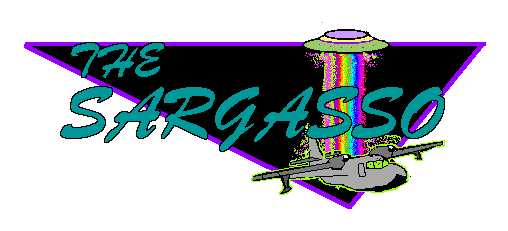

I'm not afraid! Send me back to the Bermuda Triangle
I remember as a little boy, loving the stories of the seaweed choked Sargasso Sea, the lost ghost pirate ships, and communities of savages that live in the Sargasso. I imagined the Sargasso Sea and it floating islands of seaweed being the inspiration of all sorts of fantastic tales. I always imagined the Sargasso being a very sinister, dangerous place, that you could easily enter but few could ever escape. There was even a really cool Johnny Quest episode that took place in the Sargasso. Fans of the show will remember that Dr. Quest lived on an island somewhere in the Caribbean. I digress.
Of course the truth of the Sargasso Sea is just as interesting as the fanciful tales that inspire thrill and adventure in the minds of young children.
The Sargasso Sea has really little to do with the Bermuda Triangle except a portion of its boundaries lies within the Triangle. Unfortunately this fact does little to stop writers from including tales of the Sargasso with the dreaded Triangle. If you take a peek at any globe you'll see the Sargasso Sea marked in the middle Atlantic, east of Bermuda, north of the Equator and south of the Gulf Stream.
The largest estimates plot the Sargasso between 20° N and 35° N latitude and 30° W and 70° W longitude. The sea reaches depths of 5,000–23,000 feet or 1,500–7,000 meters (see: Britannica.com). Bermuda, the Eastern edge of the Triangle is located at 32.20 N, 64.45 W. (see: CIA World Fact Book), the extreme Northwestern edge of Sargasso.Most myth supporters like to plot Bermuda as centrally located within the Sargasso; this is not the case. However proponents of the myth will then expand the dimensions of the Triangle to include the area of the Sargasso Sea, having the uninformed assume that the two are synonymous. In reality, by doing so they have more than doubled the size of the triangle, while still leaving one with the impression that everything occurred within the original boundaries.
The Sargasso is a large pool of very warm water, rotating very slowly in a clockwise manner in the middle of the Atlantic Ocean. Its circulation is powered mainly by the Equatorial Current and the Gulf Stream Current. Both of these currents push warm water passed the Sargasso and keep the water in the sea comparatively warm. These currents also affect the weather in the area. It rarely rains in the Sargasso and the weather, like the water remains very calm, very humid, and often stifling hot. It is sort of a desert existing in the middle of the ocean
The hot temperature causes the Sargasso to have a high evaporation rate while the lack of rainfall fails to add fresh water into the sea. For this reason, the salinity of the water is high. Light is able to deeply penetrate the crystal clear, calm waters of the sea. This aids the abundant plant and animal life that exists in the Sargasso.
Despite the tales, the Sea is not an endless cluster of Sargassum (sea weed). The weed does not cover the entire sea. Instead the sea is large expansive body of calm water that has millions of clusters of the weed floating around. A good land comparison would be this. The image portrayed is that the Sargassum is like jungle growth in a tropical forest. In fact it is more like shrubs in a desert. Mostly, you'll see calm, still water. The sargassum tends to migrate to the middle of the sea and it is here where you will find it at its thickest. Yet, even here, ships sail through it without fear of hinderance.
But this doesn't mean the Sargasso is not treacherous. As I already mentioned, there is very little current and very little wind. Before the advent of powered shipped, sailing in the area could be deadly. It was very slow going to cross the Sargasso. Once in the Sea is quite possible to never leave it.
The Sargasso Sea was well known, even in ancient times. Some of the earliest Greek maps indicate masses of seaweed in the Middle Atlantic. There is evidence to support that early Arabian, Phoenician and Portuguese Mariners had sailed the eastern most edges of the Sargasso. In 1436, Andrea Bianca charted the "Mer de Baga" or Sea of Berries in the Middle Atlantic.
One of the more frightening occurrences in the Sargasso is that it seems to be a catch basin for the Atlantic Ocean. Things that enter it seem to circle around until they eventually congregate in the middle and sink or just remain floating forever on the top of the water. This phenomenon has becomes very apparent thanks to pollution. One of the biggest concerns is tar balls which are formed when oil congeals in the ocean after an oil spill. Because of ocean currents these tar balls are forced into the Atlantic and eventually get sucked into the Sargasso. Unlike biodegradable waste such as seaweed and dead animals, the tar balls do not sink. They just continue to float around on the surface of the sea with no place to go. Unfortunately, the number of these tar balls is on the rise and will continue to rise with each new oil spill.
So while the Sargasso is one of natures oddities it can be explained. Still, I do like that Johnny Quest episode.